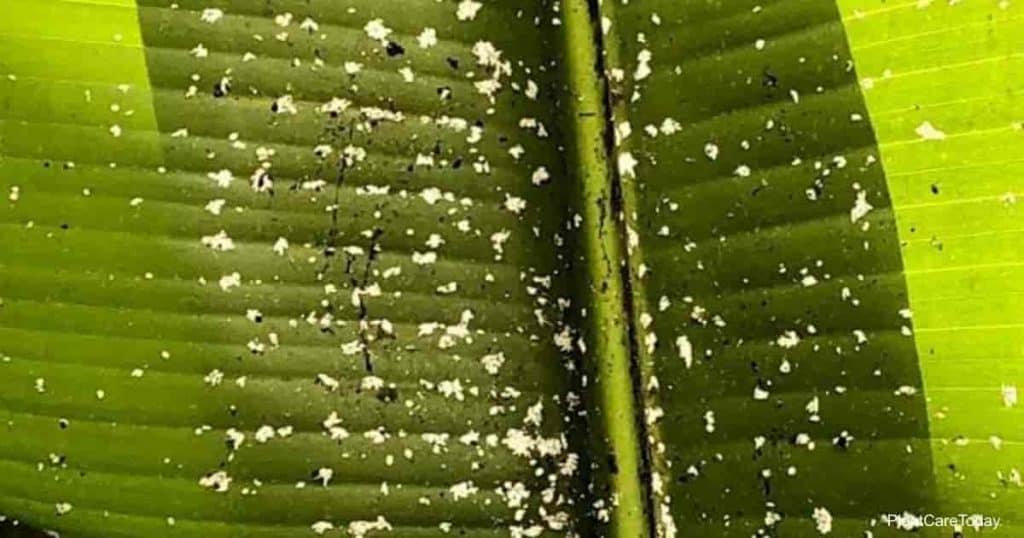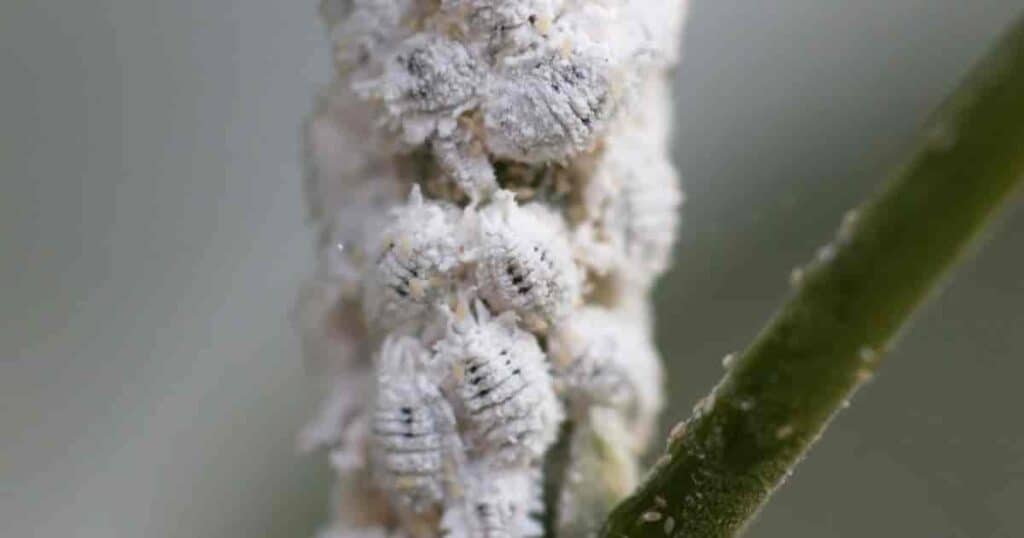If you’re here, then you’ve probably come across or even have an infestation of mealybugs in your garden or greenhouse. Those tiny, cloud-like creatures on your plants refuse to budge.
If you notice any pink, soft-bodied, and oval-shaped insects with waxy filaments extending from their rear in your garden, then you really have a mealybug infestation. The citrus mealybug (Planococcus citri) is a commonly known mealybug species.

The mealybug life cycle may be short but can do immense damage when overlooked. You also probably wondered: Are mealybugs harmful to humans?
The short answer. Unless you have allergies or you lose your plants and money, then no, they aren’t dangerous. Don’t let the name of these innocent creatures scare you.
The “mealy” part is because of the fuzz or white, powdery wax coating on their bodies, not because they see you as a meal!
Are you interested to know more? Read about to what extent this white, fuzzy bug can be harmful.
How Can Mealybugs Be Harmful to Humans?
Another question here is: Can mealybugs infest your house?

Unfortunately, yes. Mealybugs can often be found indoors, such as in your living room or glasshouse, as they thrive in warm and humid climates.
Indeed, an infestation of mealybugs isn’t dangerous to humans, but they cause some harm.
Mealybug (Honeydew) Allergy
In some cases, people experience an allergic reaction to honeydew, the waste product of mealybugs.
This allergen induces symptoms like skin irritation, skin rashes, or sinusitis when patients come in contact with the substance.
What Is Honeydew?
The sticky residue Mealybugs secrete is a substance called honeydew. Honeydew is the sugary residue that attracts feeding insects, like honeybees, and enhances mold development in plants.

This secretion contains sugar because mealybugs can only digest some of the liquid sap they ingest, and then they excrete the rest as the honeydew.
Honeydew Allergy
Honeydew allergy is common and not only caused by mealybugs on houseplants. Aside from creating a nest for fungus and sooty mold to fester, honeydew triggers an inhalant allergy in some people, while it causes skin allergies in others.
If you’re allergic, you may experience symptoms like eye redness and sneezing or skin redness and itchiness when you inhale or touch honeydew.
Mold Allergy
Leftover honeydew forms a grey-black type of fungus that looks like soot covering the plant. This mold can arouse or further provoke mold allergy in some people.
One of the main symptoms of this allergy is nasal irritation.

To Protect Yourself from Mealybugs:
If you have to come in close contact with mealybugs and fear an allergic reaction, wear a protective mask and gloves.
Be sure to wash your body parts and all tools that come in contact with mealybugs and their waste products immediately after checking your plant.
Now, you might also wonder: Can mealybugs live on humans? Or do mealy bugs bite?
Fortunately, mealybugs cannot live on humans and don’t pose a threat, as they don’t bite. However, they can spread bacteria and viruses to plants.
But can mealybugs get in your hair?
Mealybugs do not typically infest or get in human hair. They are plant pests that primarily feed on plants by sucking sap from them.
Although mealybugs can spread from clothing to hair, they do not live on humans.

Are mealybugs harmful to humans if eaten?
Mealybugs are not harmful to humans. Consuming a small number of mealybugs is unlikely to cause serious harm.
However, intentionally eating mealybugs or any other insects is not recommended as they may contain harmful substances, carry pathogens, or cause allergic reactions in some individuals.
Financial Loss
Not all harm caused by mealybugs is bodily. There’s also economic harm. The insects keep on feeding on the plant that’s under attack until it dies. If you get a mealybug infestation in your plants, they die in clusters.

Plant Death
Are mealybugs harmful to plants?
Mealybugs suck sap from plants, resulting in yellowing leaves, stunting, dieback, or plant death.
The bad news is that these insect pests don’t have a preference regarding their food. They feed on all kinds of host plants. Pothos, Ponytail, and Hibiscus.
Another example of a common host plant is the Bird of Paradise. If you notice white patches on the underside, yellowing leaves, and stunted growth, there are likely bird of paradise mealybugs.
They also attack plants at any place. You can find them on infested plants in outdoor crops and office plants.
The hibiscus even has a pest’s name after it – the Pink Hibiscus mealybug.
Here’s How Mealybugs Work On Killing Your Plant:
Sap Sucking
Mealybugs are plant sap-suckers. They feed on the plant juices from stems, leaves, and even fruits until they weaken the entire plant. You end up with a wilted and yellowed plant that eventually falls apart.
Feeding Insects
The leftover honeydew turns moldy, and its sweetness attracts insects to infest the plant as well. This is how you end up with a disaster of an insect infestation on your plant!

What Can I Do to Avoid a Mealybug Infestation?
Plant Environment
Keeping your plants in a warmer or more humid environment increases the chances of them attracting mealybugs. This is not possible with outdoor plants.
Overwatering plants attract mealybugs.
Watch out for overdoing it with the fertilizer. This makes for a fertile environment for mealybugs.
Hiding Places
- Mealybugs on succulents are the worst. They’re at their job hidden behind the fleshy leaf clusters sucking the plant to death.
- Mealy bugs don’t tend to stay in the open. Look for them hidden on the underside of plant leaves and in the nooks of your plant’s stem.
- These are even root mealybugs that live under the soil line.

Infestation Prevention
- Frequently check for mealybugs on your plants, especially when introducing new plants. They’re sadly only noticeable when they increase in population, making it harder to control their growth.
- Female mealybugs lay hundreds of eggs, which are placed in the crevices of the plants. The best approach is to wipe foliage.
- Your best bet is to isolate a plant when you find mealybugs on it completely. That way, you protect your vegetation from infestation.
- Try saving a plant from mealybug infestations in its early stages by applying insecticidal soaps, dish soap, neem oil, and insecticides or dabbing the mealybugs with cotton swabs soaked in rubbing alcohol.
- When spraying natural solutions or pesticide chemicals, make sure to spray the underside of the leaves.
- Try introducing natural predators, such as ladybugs, parasitic wasps, beetles, lace bugs, lacewings, and other mealybug destroyers (Cryptolaemus montrouzieri), to control the mealybug population.
- If you find a plant with a heavy mealybug infestation, consider getting rid of it altogether.

In The End – Do Mealybugs Harm Humans?
Mealybugs are tame creatures when it comes to humans, except for occasional allergic reactions to people. The major loss mealybugs are responsible for is killing plants, sometimes in batches.
Next time you see a mealybug lurking on your plant, take precautions, and don’t be bugged about it! They don’t bite. Puns intended.